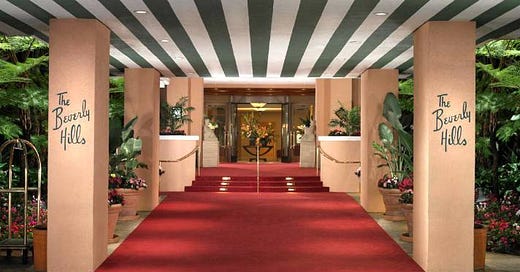It’s Design Lobster #38. This week we’re getting design tips from a celebrated Black American architect. Plus, what the history of screws reveals to us about over-optimising a design. 🔩
✨Enjoying Design Lobster? Please share it with a friend, colleague or fellow designer.
Question: Why did architect Paul R. Williams like to draw upside down?
Above: The entrance to the Beverley Hills Hotel, designed by Williams.
Paul Revere Williams worked prolifically on over 2500 buildings in the Los Angeles area between 1923 and 1980. He was the first Black architect to become a member of the American Institute of Architects, and in 1957, its first Black fellow. I recently read his candid account of becoming an architect against the odds: I am an architect. In it, he describes an unusual kind of design session:
…I spent hours learning to draw upside down. Then with a client seated across from me, I would rapidly begin to sketch the living room of his house. Invariably his interest would be excited by the trick.
But it was more than a trick, for, as the room developed before his eyes, I would ask for suggestions and for approval of my own ideas. He became a full partner in the birth of that room as I filled in the details of the drawing.
By turning the drawing around, Williams gave his clients the impression that they were leading the design. More than just a client, in his words they became a partner in his design process.
Of course, his adoption of this technique came from a place of brutal necessity – as a way to counter his clients’ instinctive racism. We should lament that this was the reason he had to draw this way. Nevertheless, I think in this practice there is something to learn about how to make participants in any design process feel more included and in control. The design process can be intimidating, especially to disadvantaged groups, and it is part of our responsibilities as a designer to try and find ways to make it less so.
Design takeaway: What small changes to your process could you make to ensure your client/customer/user felt more included?
👨🏾🦳Listen to a podcast about Paul Revere William’s work in Hollywood.
Object: Robertson screw
Above: A 1909 advertisement for the Robertson screw.
In the early 20th century, two new types of screw battled for supremacy in American manufacturing. On one side, the Philips with a cross-shaped indentation in the head, on the other, the Robertson, with a square hole. Both designs aimed to solve the issue of drivers slipping out of the head – a general problem of slotted screws.
The Canadian Peter Lymburner Robertson had a head start with his screw, inventing it in 1908, 22 years earlier than the Philips. His design was also superior at keeping a driver locked into the head - it’s much easier to turn a Robertson screw one-handed for example.
However, as anyone who has done a DIY project will know, the Philips design won out. This is often put down to Robertson’s refusal to license the design to Henry Ford preventing it from becoming the standard. This no doubt played a part. However one more subtle design difference was also crucial. On a production line, the tendency of the Philips-head screwdriver to slip out once the screw was tight became a big advantage. The Robertson head was so effective at keeping in the driver that it was easy to overtighten causing damage. Production line operatives preferred the Philip’s head, even though it was not quite as secure, because it was more forgiving to work with.
There’s a lesson here for designers, if your design focuses too narrowly on one aspect of a problem it might fail to truly solve it. Don’t forget to zoom out now and again.
Design takeaway: Are you over-optimising your design?
🔩 All you could possibly want to know about the history of screws - video.
Quote: “Good designers can create normalcy out of chaos.”
– Jeff Veen, founder of Adaptive Path
I confess I strongly identify with this quote. So often as a designer you are presented with a tangled heap of competing requirements and must sift through and re-envision what you find. Design is the process of exploring, refining and reconfiguring what can feel like a mess.
If anything I would go further than Jeff and say the task is not to create mere ‘normalcy’, but something that goes beyond this. The best design has a clarity of intention that lifts it above the the general chaos of ordinary life.
Keep discovering,
Ben 🦞
Has this email been forwarded? Sign up below to get the weekly emails delivered to you. ✏️






Here from the Substack Bridge program! Congrats on getting in. Really love your content.
Your design takeaways are always very thought provoking!
Design takeaway: Are you over-optimising your design? This prompted two very different trains of thought.
(1) Reminds me of my writing, sometimes. When I'm very sloppy and unintentional, it's not very engaging. But when I try too hard (to sound a certain way or use a certain style that is not mine), it can come across as unauthentic. There is something right in the middle which is my authentic voice (albeit well written) which I think ends up sticking most with readers.
(2) Reminds me of the idea of introducing useful friction in products. At Thumbtack we could have made discovery of local professionals very easy (here's a directory listing, go hire). But there was value in adding a bit of friction for both sides (filling out a detailed request form). It helped us find the most relevant professional to serve the customer's needs, and the time invested by the customer to fill out his/her request gave professionals confidence that they were serious about getting the work done.